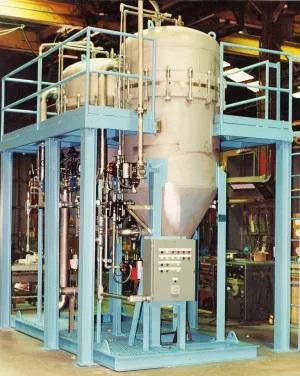High-quality water with ionic impurity concentrations as low as 0.1 ppb is required for a range of industrial applications such as process water and feed water for once-through steam generators or drum boilers.
High-quality water produced by a reliable condensate polishing system minimizes corrosion and reduces the transport of impurities such as iron particulate into the steam generators. Condensate polishers use a type of ion technology to ensure a cycle of constant, pure water production. The design of water polishers helps remove impurities while producing a flow of clean water with minimal pollution. The deposition of undesirable constituents around steam and water circuits can result in a build-up of scaling, which causes equipment downtime and higher operating costs. A quality water polishing system will help with contamination control and removal.
Some of the main sources of condensate contamination are:
-
Silica originated from poorly operated demineralized makeup water treatment systems, wash-down wet steam from turbine blades, and other steel components upstream of the boiler system.
-
Overdosing of treatment chemicals that produce additional impurities from poorly treated dilution water.
-
Leakage of cooling water with higher total dissolved solids (TDS) from the condenser.
-
Iron or copper oxides in dissolved or particulate form resulted from metal components exposed to oxygen in the air during shutdowns and restarts.
Condensate polishing operations rely on ion exchange technology consisting of selective columns capable of reliably and consistently producing water with minimal impurities and almost zero leakage.
The exchange of ions is achieved through the use of resin beds contained in two or more separate vertical pressure vessels. The process flows in series as raw water enters the cation exchange vessel and passes down through the resin bed where calcium, magnesium, sodium, and other cations are removed from the water in exchange for hydrogen ions. The water then passes through the anion exchange vessel where chloride, sulfate, bicarbonate, and other anions are removed in exchange for hydroxide ions. When the hydrogen and hydroxide ions on the resins have been replaced by the cations and anions from the water, the deionization reaction stops, and the resins need regeneration.
By continuously removing suspended and dissolved impurities such as sulfates, silica, iron and copper oxides, carbon, and other volatiles, condensate polishing brings a more reliable system, with reduced blowdown that produces considerable heat savings. Condensate polishing also decreases equipment downtime by lowering the frequency of chemical cleaning and minimizing the potential for corrosion of valves and other components.
Veolia provides high-capacity cation and mixed-bed ion exchange polishers, advanced Auto-Shok pre-coat filter polishers, and combined options that maximize condensate polishing performance and minimize operating costs by removing both soluble and insoluble contaminants from boiler feed-water. Whichever type of condensate polishers you may need, our team of specialists can help you.




